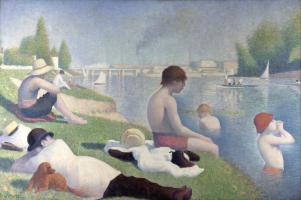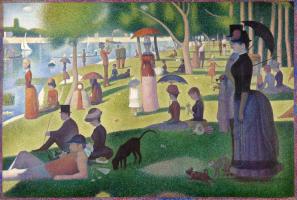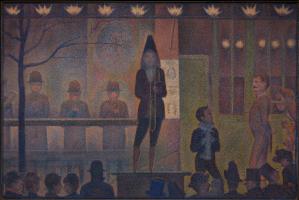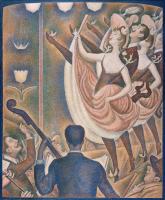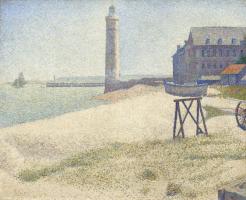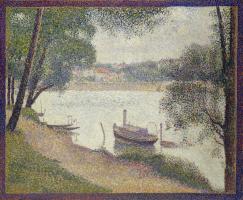Georges Seurat
Georges Seurat’s brief life included a short academic art training in Paris, a year of military service, and a decade of intense work and artistic investigation. He died when he was thirty-two, but by then he had produced a handful of masterpieces which reveal his intelligent and rational approach to the problems of colour and light. He wanted to be able to apply a scientific system to the methods of the Impressionists, and he evolved a new technique which came to be known as Pointillism, in which he applied the paint in small dots of different colours which blend in the eye of the spectator rather than on the canvas.
 Seurat combined several techniques in The Bathers as well as the features he
was fully to develop in his later work. His pointillist theory was not entirely
formed when he painted it, and he later added dots of colour in certain areas
to heighten their intensity, but the principles behind his colour analysis are
already evident. His aim was to achieve the exact interplay of colour and
light in the open air, and, to this end, each area of shadow was broken down
into the complementary colours of the surrounding areas of light, and every
element in the painting — the grass, the water, the flesh tones —
was made up of colour reflected from the objects next to it. There is
something of the Impressionist style in the brushwork and the effects of light;
but Seurat conveys not so much the light-heartedness to be found in their work
but more the dignity and solemnity of everyday life.
Seurat combined several techniques in The Bathers as well as the features he
was fully to develop in his later work. His pointillist theory was not entirely
formed when he painted it, and he later added dots of colour in certain areas
to heighten their intensity, but the principles behind his colour analysis are
already evident. His aim was to achieve the exact interplay of colour and
light in the open air, and, to this end, each area of shadow was broken down
into the complementary colours of the surrounding areas of light, and every
element in the painting — the grass, the water, the flesh tones —
was made up of colour reflected from the objects next to it. There is
something of the Impressionist style in the brushwork and the effects of light;
but Seurat conveys not so much the light-heartedness to be found in their work
but more the dignity and solemnity of everyday life.
He was equally absorbed in the study of composition, and his major paintings and small landscapes are the results of extremely careful preparation. For The Bathers he made no less than fourteen small paintings and ten drawings before putting together this formal and precise composition. It now seems as if the arrangement was inevitable: the placing of the figures, the spaces between them, and even the points of colour on each fine blade of grass are essential parts of the carefully calculated scheme.
 Seurat’s early work was received with consternation and criticism, but for the
last five years of his life he found himself the centre of a cult, and his
effect on modern art has been considerable.
Seurat’s early work was received with consternation and criticism, but for the
last five years of his life he found himself the centre of a cult, and his
effect on modern art has been considerable.
The Sideshow is a wonderfully atmospheric, skillfully composed picture of a travelling fair, with the oil and gas lamps reliving the gloom of a winter’s evening, and tempting the audience to some escapist entertainment.

